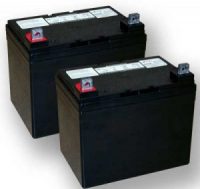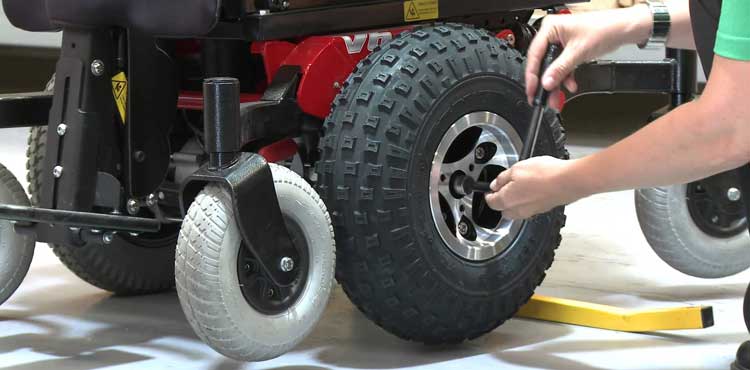You rely on your electric wheelchair every day, so regularly maintaining it will keep it running smoothly for years to come. Follow these maintenance tips for your electric wheelchair to reduce service costs and the inconvenience of waiting for repairs to be completed.
Establish a daily and weekly routine using our tips for keeping your wheelchair running smoothly, and ask your caregivers or family members to help, especially if you are unable to remain steady on your feet while inspecting and cleaning the chair.
- Your Electric Wheelchair Toolkit
Create a toolkit to make maintaining your electric wheelchair easier. Once you gather all the tools and cleaners you need, keep them together in a bag that zips or has another easy-open closure. You may find some specific tools recommended in your chair manual, and you will want to add things like:
- Several small soft cloths
- A towel
- Spray bottle of mild cleaner or cleaner to be diluted in a bucket of water
- A small bucket to hold rinse water
- A second bucket for wash water if you don’t use a spray cleaner
- Flat-head screwdriver
- Phillips screwdriver
- Allen wrench
- Toothbrush or small cleaner brush
- Electric wheelchair tire repair kit
An economical, gentle and effective soap we recommend is Simple Green (Buy on Amazon), found in just about all hardware stores and big box retailers. Follow the directions on the Simple Green concentrate bottle to dilute to a daily cleaner. If you have more stubborn cleaning, such as crusted-on food, you can use a stronger dilute to clean it. Another good option is ammonia-free glass cleaner.
Remember: Never use an oily cleaner on your electric wheelchair, and especially not on the tires
- Daily Electric Wheelchair Cleaning
It’s essential that all parts of the wheelchair are washed daily with the spray cleaner or a bucket of warm soapy water when you are finished using your electric wheelchair each day. Built-up dirt and food deposits can cause your wheelchair mechanisms to wear out faster. This cleaning won’t take long when done each day. Once you wash the chair, go over it again with a fresh cloth dampened only with water, then dry everything off with a dry towel. Check all the small spaces for any moisture.
You use the controller so frequently each day that a daily wipe down keeps dirt and oil from your skin from building up in any crevices.
- Electric Wheelchair Battery Maintenance
 Source: Hoveround
Source: HoveroundDon’t put off charging your electric wheelchair battery, even if you haven’t used the chair much for the day. Not only will you want to be sure the battery has plenty of power for what the next day brings, but proper care extends the life of the wheelchair battery. Along with nightly battery charges, the United Spinal Association’s New Mobility Magazine makes these recommendations to maintain your battery:
- Always charge a new electric wheelchair battery to the fullest
- Don’t let the charge level go below 70 percent the first 10 days of battery use
- Try not to drain batteries by more than 80 percent
- Use the charger that comes with the battery or chair
- Keep Your Electric Wheelchair Dry
Corrosion can occur any time your wheelchair is exposed to the elements, so make sure your electric wheelchair is dry after each outing. Take extra precautions by drying electrical components like the controller and wire well.
While it’s best not to use electric wheelchairs in the rain or snow, sometimes doing so is necessary. If you must use your chair in the rain or snow, the Wisconsin Department of Health and Family Services recommends wrapping a clear plastic bag over the power control panel to protect it from the elements.
- Electric Wheelchair Tire Maintenance
Keep your tires inflated at the pressure level stamped on the tire or listed in the operating manual. Underinflation can cause your electric wheelchair to wobble or veer off to one side when you want to drive straight. Overinflated or underinflated tires can wear unevenly and are likely to not last as long.
Tubeless tires are popular in many electric wheelchair models. Instead of an inner tube, they use a sealant that coats the inside tire wall. This helps prevent flats. If you run tubeless tires on your electric wheelchair, maintaining the proper air pressure is essential. Too low of tire pressure could cause pinch flats where the tire wall pinches against the rim of the wheel.
 Source: YouTube
Source: YouTube - Weekly Electric Wheelchair Maintenance
Each week, add these steps to your daily cleaning routine to identify any maintenance your electric wheelchair needs:
-
Check for sharp edges by sitting in the electric wheelchair and running your hands over all parts to feel for tears or sharp edges and take care of these right away. If you can’t fix the problem, make an appointment to bring the chair in to have it professionally maintained.
-
Wiggle around in the seat to be sure the back and seat feel secure. Tighten the bolts of any component that feels loose. Check other nuts and bolts around the chair to be sure they are all tight as well.
-
While seated in the chair, look down at the footwells. Are your feet well-supported? Make any needed adjustments.
-
Take a walk around the wheelchair to check for wires hanging loose. Refer to your manual to determine where the wires should be and reposition or tie them down with zip ties.
-
Listen to the motor and if anything sounds off, check the electric wheelchair manual to determine if there’s any troubleshooting you can do on your own. If not, get in touch with a repair shop. If you haven’t already cleaned the motor cover, do so now and keep an eye out for cracks.
-
- Your Wheelchair Manual
Remember to get familiar with your wheelchair’s operating manual to understand any features or maintenance information that is specific to your make and model. You’ll also find safety suggestions and maintenance information. The manual will have important phone numbers to call should you need help troubleshooting an issue or finding a repair shop. When you finish reading the manual, keep it with your cleaning kit or file it away someplace you can easily find.


